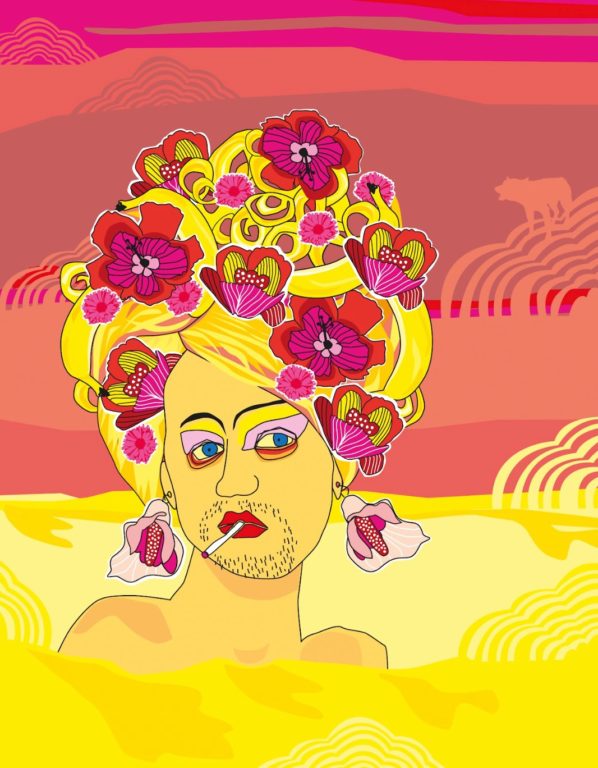[ad_1]
1994 was a huge year for cinema. Pulp Fiction, Forrest Gump, Speed, The Lion King… And also a small, off-beat Australian road-trip comedy, The Adventures of Priscilla, Queen of the Desert.
Camp as a row of tents, it centred on two gay men, one transsexual woman, and a big, shiny, silver 1976 Hino RC320 bus on a journey across the unimaginable vastness of the Australian outback, numerous quirky stops along the way.
For me, it seeded an obsession with a place called Coober Pedy. It was there, somewhere north of Adelaide, that Terence Stamp – driest of the film’s three drag queens – uttered the film’s crudest word bombs as his character, Bernadette, arm-wrestled a butch bigot named Shirley and then drank her under the table, too.
The town’s mystique fermented in my imagination, not for its population of presumably homophobic mineworkers but, because – research informed me – half its population dwelt underground.
Yes, somewhere along the Stuart Highway, modern-day humans were living in caves carved from soft desert substrate. I had to see it for myself.
Fifteen years later I finally found my way there. On a convoluted trip to Uluru (Ayers Rock) – where, in another movie, Meryl Streep uttered, ‘That dingo stole my baby!’ in purest Australian drawl – Coober Pedy would break my two-day Greyhound ride from Adelaide to Alice Springs.
I arrived after dark, found my way through the eerily empty streets, and descended the stairs of my subterranean hotel where there was no way of telling night from day. The lack of any outside view meant it was a real shock to find the sun up when I emerged topside the following morning.
I might have slept through the end of the world. The town sat barren and post-apocalyptic amid South Australia’s rolling gibber plains and red sand hills; to the naked eye, it was a place already dead.
But there was a pulse.

Illustration by Jess Nicholson
Situated on a 120-million-year-old inland seabed studded with opalised dinosaur and marine fossils, the optimistically nicknamed “Opal Capital of the World” exploded into existence after the discovery of the gemstone motherlode in 1915. Aboriginals called it kupa piti, literally “white man’s hole” – a fitting description for a place that, in the ensuing rush, transformed into a 20th-century boom town feverish with burrowing miners, many having fled war-ravaged Europe.
When the dust settled and fortunes faded, die-hards remained, many within the shrunken gene pool ultimately pivoting to tourism. Plus, the town caught on as a living, breathing movie set, something straight out of our climate change-pummelled future. Scrap from Mad Max: Beyond Thunderdome, the spaceship from Vin Diesel’s Pitch Black, and detritus from other films that have been shot there could be seen next to the main street.
If the town was pure sci-fi, the enfolding desert was straight from the surface of another world. The minefields were so riddled with scars and dongas and craters and left by the mad rush for gemstones, our guide wouldn’t let us out of the bus in case someone fell down a shaft.
And then there was the Mail Run Tour, a 12-hour outing that doubles as the official postal delivery service, dropping packages at some of the remotest outposts on the planet. We visited a homestead on the world’s largest cattle station, and drove alongside the 5 300km Dog Fence, erected to protect sheep from dingoes that dwell on the aptly named Moon Plain.
We visited distant places with names like Oodnadatta and William Creek. The latter, once a bustling railway post, is among Australia’s smallest towns (permanent population: six), little more than a hotel and fuel station close to a former nuclear test site, with a famed salt lake and pretty “painted hills” among its attractions. We had kangaroo burgers and decent coffee in its diner-style pub – sustenance for the long trek back to Coober Pedy, our mailman’s endless narration never pausing for a moment.
Next day, with another tour guide, I visited a cave-museum that once was home to an illustriously handsome hermit. He’d accrued celebrity-stud status by luring women to visit him for amorous affairs. Over years he assembled keepsakes from his multifarious conquests – candid photographs, love letters, panties. His cave had become a shrine.
It was Coober Pedy’s cemetery, though, that really spun my head around. Many of the headstones were decorated with quirky illustrations of the traits and peculiarities and foibles of whomever was buried beneath. The vast majority were Christian graves, all lined up in orderly rows. But, amidst these, was a handful of gravestones arranged at oblique angles, discernibly out of sync with the rest.
‘These are Muslim graves,’ our guide said. ‘Facing Mecca.’
In a bizarre twist, I thought, here was some form of extreme religious tolerance, a place where everyone – no matter their beliefs – was interred on the same patch of sacred ground.
Thanks to Priscilla’s depiction of the town’s residents as rough-edged hard-drinkers and lousy arm-wrestlers, I’d arrived with assumptions about the narrow-mindedness and insularity of an isolated community. Instead, when I gazed below the surface, what I found were rare expressions of humanity.
This article originally appeared in the April 2022 print edition of Getaway
Words by Keith Bain
[ad_2]
Source link
Jarastyle – #Human
Courtesy : https://www.getaway.co.za/travel-ideas/human-after-all/

